
Cappoquin House also known as Belmont is an 18th-century classical-style mansion overlooking the town of Cappoquin in County Waterford, Ireland. The house is the seat of the Keane Baronets of Belmont and of Cappoquin.

Cappoquin House also known as Belmont is an 18th-century classical-style mansion overlooking the town of Cappoquin in County Waterford, Ireland. The house is the seat of the Keane Baronets of Belmont and of Cappoquin.
It is believed that the house was built on the site of an old Fitzgerald castle, of which the earliest known reference dates to 1598 when it was occupied by a Mr. Hayles and razed by Thomas Fitzgerald of Cappagh, who had probably forfeited it in the Desmond Rebellions. In 1641 Capt. Hugh Croker on behalf of the Earl of Cork occupied the castle, and successfully resisted an assault by the Confederate Catholics under General Purcell in 1643. However, it surrendered to Lord Castlehaven in 1645. It was subsequently captured by Cromwell in 1649. Nothing remained of the castle, apart from one wall with a narrow doorway leading to a garden when it was surveyed in 1918. [1]
The current house was built in 1779. It is believed to have been designed by John Roberts, a noted Waterford architect. [2] The building is a detached seven-bay two-storey over basement house surrounded by notable formal gardens and landscaped grounds which are open to the public. [3]
The house was burnt out on 19 February 1923 during the Civil War, but Sir John Keane, whose family had owned the house for generations, fully restored it as economically as possible using recycled materials and direct labour. [4] He built a flat concrete roof using a technique developed by James Hardress de Warrenne Waller known as Nofrango. [2] In November 1973 during a dispute with tenants over ground rents, a milking parlour on the estate was destroyed by a 50 lb (23 kg) bomb. The Official IRA were believed to be responsible. [5]
The landscaped gardens are the work of Lady Olivia Keane who, after years of neglect following World War I, designed the grounds. There are some fine trees, Japanese cedars, maples and a southern beech, and a venerable oak that is included in Owen Johnson's Champion Trees of Britain and Ireland. Higher on the slopes are terraces with rhododendrons, azaleas, camellias and magnolias, and everywhere, fine views over the surrounding countryside. [4]
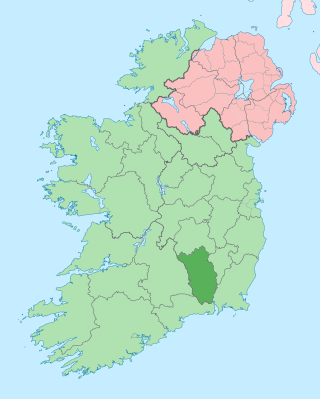
County Kilkenny is a county in Ireland. It is in the province of Leinster and is part of the Southern Region. It is named after the city of Kilkenny. Kilkenny County Council is the local authority for the county. At the 2022 census the population of the county was 103,685. The county was based on the historic Gaelic kingdom of Ossory (Osraighe), which was coterminous with the Diocese of Ossory.

Anglesey Abbey is a National Trust property in the village of Lode, 5+1⁄2 miles (8.9 km) northeast of Cambridge, England. The property includes a country house, built on the remains of a priory, 98 acres of gardens and landscaped grounds, and a working mill.

Castlepollard is a village in north County Westmeath, Republic of Ireland. It lies west of Lough Lene and northeast of Lough Derravaragh and Mullingar.
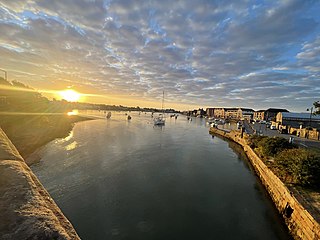
Dungarvan is a coastal town and harbour in County Waterford, on the south-east coast of Ireland. Prior to the merger of Waterford County Council with Waterford City Council in 2014, Dungarvan was the county town and administrative centre of County Waterford. Waterford City and County Council retains administrative offices in the town. The town's Irish name means "Garbhann's fort", referring to Saint Garbhann who founded a church there in the seventh century.
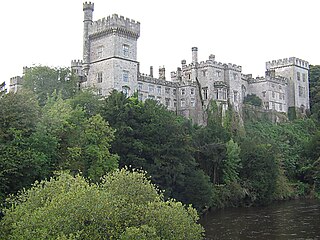
Lismore is a historic town in County Waterford, in the province of Munster, Ireland. Originally associated with Saint Mochuda of Lismore, who founded Lismore Abbey in the 7th century, the town developed around the medieval Lismore Castle. As of the 21st century, Lismore supports a rural catchment area, and was designated as a "district service centre" in Waterford County Council's 2011-2017 development plan. As of 2016, the town had a population of 1,374 people.

Cappoquin, also sometimes spelt Cappaquin, is a town in western County Waterford, Ireland. It is on the Blackwater river at the junction of the N72 national secondary road and the R669 regional road. It is positioned on a sharp 90-degree bend in the river and lies at the foot of the Knockmealdown Mountains. The town is a few miles from Mount Melleray and Lismore, County Waterford.

Emo Court, located near the village of Emo in County Laois, Ireland, is a large neo-classical mansion. Architectural features of the building include sash-style windows, pavilions, a balustrade, a hipped roof, and large dome.
Villierstown is a village in west County Waterford, Ireland. It is situated on the banks of the River Blackwater, and was founded in the 1740s by a local landlord, John Villiers, as a base for the linen industry, and initially populated primarily from Lurgan. In the census of 2016, the population of the village was 276.

Ballyhack is a small village located in the south-west of County Wexford, in Ireland, on the eastern shore of the Waterford Harbour, which is the estuary of The Three Sisters

Mount Loftus is a country estate in the civil parish of Powerstown in County Kilkenny, Ireland. It was originally home to the Loftus baronets, the baronetcy being extinct since the death of the third baronet in 1864. The original 18th century manor house was demolished in 1906. The current house on the estate, built in the early 20th century, was rebuilt from staff accommodations after a fire in the 1930s. This house, and several of its outbuildings, are included on Kilkenny County Council's Record of Protected Structures.
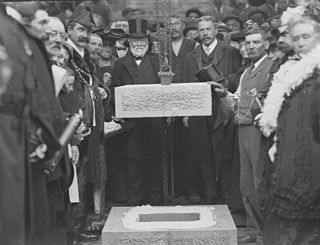
Waterford City Library, also known as the Central Library, is a public library in Waterford, Ireland. It was the first to be built of Ireland's many Carnegie libraries. The philanthropist Andrew Carnegie, who had previously opened libraries in Scotland and the US, himself laid the foundation stone in 1903.
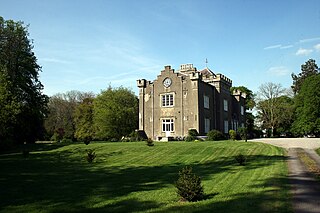
Shankill Castle and Gardens is set in parkland near Paulstown on the Carlow/Kilkenny border. Visitors are invited to walk in the grounds and gardens, and there are guided tours of the house.
John Benjamin Keane was an Irish architect of the 19th century. (d.1859). He was engineer on the River Suir navigation.
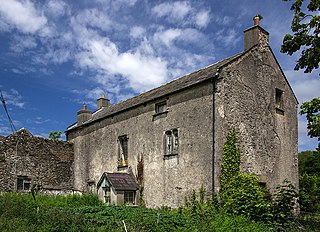
Ballygunner Castle is a country house in the Ballygunner area of County Waterford in Ireland. It is believed to be built on the site of a former Viking stronghold. The main structure of the house includes a combination of medieval and 17th century building, with evidence of further modifications in the 18th and 19th centuries.
The High Sheriff of County Waterford was the Sovereign's judicial representative in County Waterford. Initially, an office for a lifetime, assigned by the Sovereign, the High Sheriff became an annual appointment following the Provisions of Oxford in 1258. Besides his judicial importance, the sheriff had ceremonial and administrative functions and executed High Court Writs.
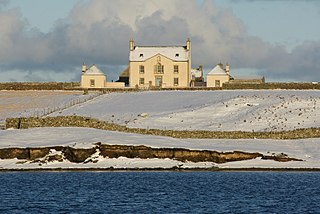
Belmont House is a neo classical Georgian Country House Estate on the island of Unst, the most northerly of the Shetland Islands, [United Kingdom] and also of Scandinavia. It was constructed in 1775 by Shetland landowner Thomas Mouat of Garth who was a local Shetlander. The Estate has been described as "possibly the most ambitious, least-altered classical mansion in the Northern Isles." The house was restored from a derelict state between 1996 and 2010 by the community and local interest groups and Trust. The house is now owned and run by Martin Wilson who uses the house as his home but also, from time to time, as a venue for events and for bed and breakfast.
The destruction of country houses in Ireland was a phenomenon of the Irish revolutionary period (1919–1923), which saw at least 275 country houses deliberately burned down, blown up, or otherwise destroyed by the Irish Republican Army (IRA). The vast majority of the houses, known in Ireland as big houses, belonged to the Anglo-Irish upper class known as the Protestant Ascendancy. The houses of some Roman Catholic unionists, suspected informers, and members or supporters of the new Irish Free State government were also targeted. Although the practice by the IRA of destroying country houses began in the Irish War of Independence, most of the buildings were destroyed during the Irish Civil War (1922–23). Today, most of the targeted buildings are in ruins or have been demolished. Some were restored by their owners, albeit often smaller in size, or were later rebuilt and re-purposed.
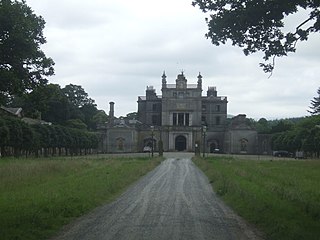
Curraghmore near Portlaw, County Waterford, Ireland, is a historic house and estate and the seat of the Marquess of Waterford. The estate was part of the grant of land made to Sir Roger le Puher by Henry II in 1177 after the Anglo-Norman invasion of Ireland.
Woodhouse is a Georgian mansion and c. 500-acre estate just outside the village of Stradbally, County Waterford, Ireland.
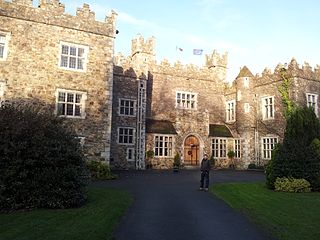
Waterford Castle is a historic house on Little Island in Waterford, Ireland. The house was owned by a branch of the Fitzgerald family for hundreds of years, but was developed into a hotel in the 1980s.